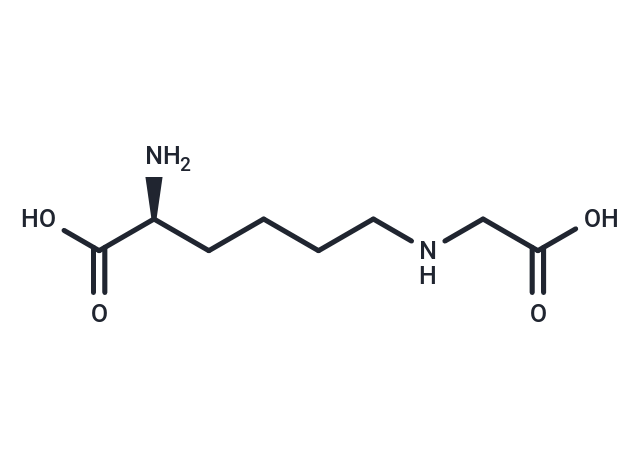- 全部删除
 您的购物车当前为空
您的购物车当前为空
Nε-(1-Carboxymethyl)-L-lysine
Nε-(1-Carboxymethyl)-L-lysine (CML), an advanced glycation end product (AGE), is formed through the oxidative modification of glycated proteins under conditions of oxidative stress.1,2,3 Its levels escalate with age, diabetes, cancer, vascular diseases, and various pathologies associated with oxidative stress.1,4,5 CML interacts with the membrane-bound receptor for AGEs (RAGE), initiating signaling via MAPKs and NF-κB pathways. Conversely, a truncated version of RAGE generates a soluble protein that sequesters CML, thereby diminishing this signaling.6,7

Nε-(1-Carboxymethyl)-L-lysine
Nε-(1-Carboxymethyl)-L-lysine (CML), an advanced glycation end product (AGE), is formed through the oxidative modification of glycated proteins under conditions of oxidative stress.1,2,3 Its levels escalate with age, diabetes, cancer, vascular diseases, and various pathologies associated with oxidative stress.1,4,5 CML interacts with the membrane-bound receptor for AGEs (RAGE), initiating signaling via MAPKs and NF-κB pathways. Conversely, a truncated version of RAGE generates a soluble protein that sequesters CML, thereby diminishing this signaling.6,7
| 规格 | 价格 | 库存 | 数量 |
|---|---|---|---|
| 10 mg | 待询 | 8-10周 | |
| 50 mg | 待询 | 8-10周 |
产品介绍
| 产品描述 | Nε-(1-Carboxymethyl)-L-lysine (CML), an advanced glycation end product (AGE), is formed through the oxidative modification of glycated proteins under conditions of oxidative stress.1,2,3 Its levels escalate with age, diabetes, cancer, vascular diseases, and various pathologies associated with oxidative stress.1,4,5 CML interacts with the membrane-bound receptor for AGEs (RAGE), initiating signaling via MAPKs and NF-κB pathways. Conversely, a truncated version of RAGE generates a soluble protein that sequesters CML, thereby diminishing this signaling.6,7 |
| 别名 | CML |
| 分子量 | 204.2 |
| 分子式 | C8H16N2O4 |
| CAS No. | 5746-04-3 |
| 存储 | Powder: -20°C for 3 years | In solvent: -80°C for 1 year | Shipping with blue ice. |





 还可以
还可以

评论内容